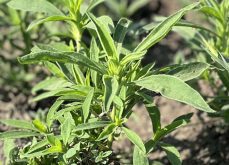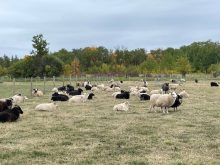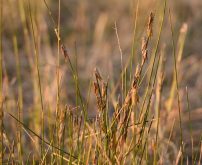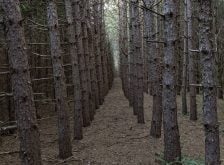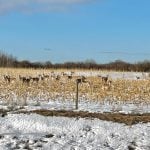It’s farm equipment that does the bulk of disease spread
In Part I of this discussion on plant disease and weed issues, I explored clubroot of canola. Now for the other nine listed and destructive disease and weed issues on my top 10 list. All nine of these disease and weed issues move from cropland to cropland in exactly the same way as clubroot of canola. See the previous issue for guidelines on disease prevention.
CEREAL CYST NEMATODE
Nematodes are referred to as roundworms or eelworms, and despite being of animal origin, they are studied by plant pathologists worldwide and not by entomologists as many Canadians believe.
Read Also
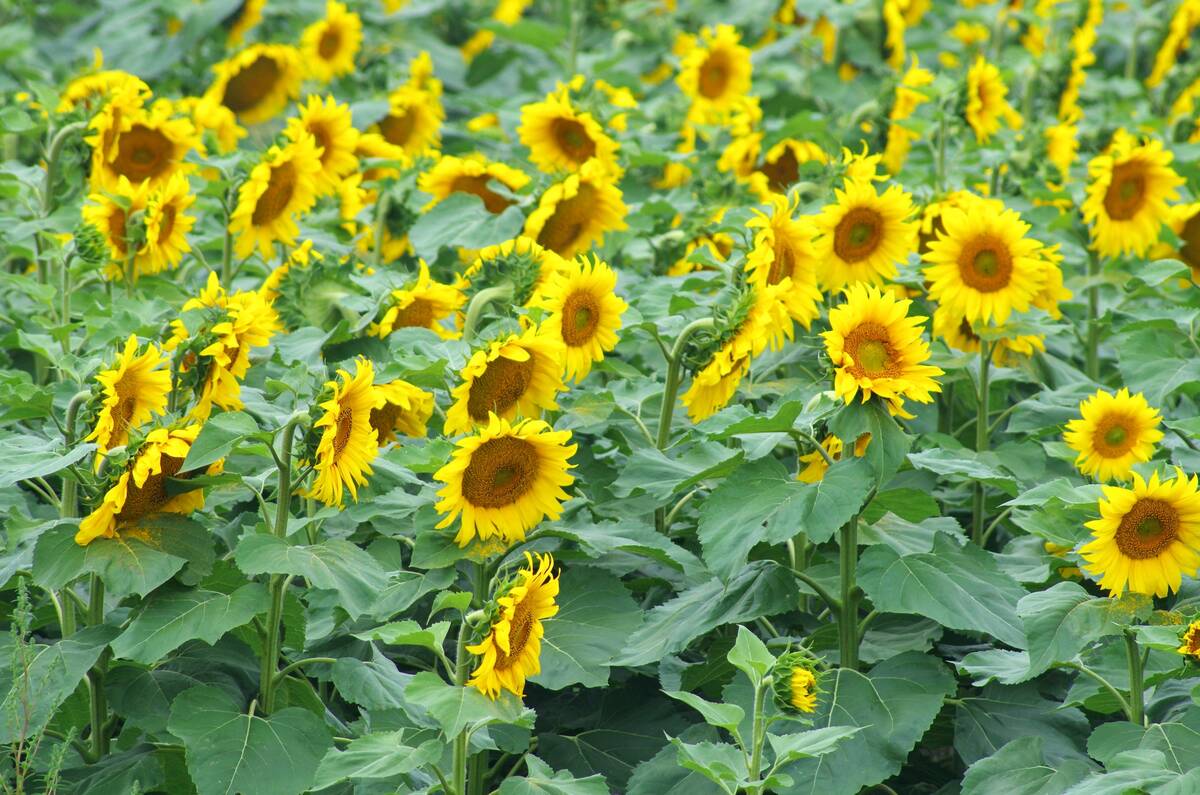
Made-in-Manitoba sunflower hybrid headed to market
Manitoba’s confection sunflower growers will have a new seed option next spring developed specifically for performance in the province. The…
Cyst-forming nematodes have been found in recent years in many fields in Montana, parasitizing wheat in particular. These destructive root-feeding nematodes can cause substantial yield losses of up to 50 per cent.
Named a cyst nematode because it forms rounded, dormant cysts on cereal roots, it can remain in the soil for many years. In Montana, this nematode has been identified as Heterodera filipjevi, closely related to H. avenae, the oat cyst nematode, which is common in some parts of Ontario.
During the spring months, juvenile nematodes emerge from dormant cysts in cropland soil. These newly hatched nematodes attack the cereal roots, eventually forming new cysts visible to the naked eye.
These cereal cyst nematodes are presently showing up frequently in all of the bordering U.S. states in cereal crops.
Technically, these nematodes, like many soil-borne diseases, could be prevented from entering Canada if only we stick to sanitary procedures.
In other words, any farm vehicles coming into Western Canada from the United States should be free or reasonably free of mud and earth clods. That is the primary way that nematodes can spread onto new cropland and enter the Canadian Prairies.
SOYBEAN CYST NEMATODE
Soybean cyst nematode (SCN) is widespread and causes one of the most destructive soybean diseases in Ontario. This nematode, Heterodera glycines, causes big yield losses worldwide in soybeans.
Soybean cyst nematodes, which can cause yield losses of up to 40 per cent, have been found at several soybean field locations in Manitoba.
Cysts of this pest can last in the soil for up to 10 years. How does this nematode get around? The same way as clubroot of canola is moved from field to field.
This nematode likely entered Manitoba cropland from infested soybean fields south of the border — probably mud clods on agricultural machinery.
Spread of this soybean nematode on Prairie soybean fields will depend primarily on vehicles carrying mud with the dormant cysts (eggs) from field to field.
There are SCN-resistant soybeans that might be suitable for Manitoba conditions. This SCN resistance, though, is just like that of clubroot of canola, it eventually breaks down.
Soybean growers in the Prairies should adopt prevention methods like those for clubroot as soon as possible to prevent major soybean crop yield losses.
APHANOMYCES (BROWN ROT)
Aphanomyces is a very destructive fungal disease that is spread by mud just like clubroot. Pea and lentil growers should be very careful of contaminated soil entering their cropland.
I have seen this water mould fungus take out 90 per cent of pea crops and big swaths of destruction on lentil crops.
There are no resistant varieties in either peas or lentils to this devastating fungus. Once your fields are infested by this fungus you can kiss growing peas goodbye more than once every eight to 10 years. Keep this and other soil-borne diseases out of your cropland. Yes, it can be done.
You can no longer walk into any successful hog operation’s barns. Hogs are quarantined to prevent the introduction of infectious diseases.
VERTICILLIUM WILT
How did Verticillium longisporum, which causes the miserable, destructive fungal disease verticillium wilt of canola, get from Europe to a canola field in Manitoba? Someone, somewhere was negligent. Soil or diseased cruciferous plants had to have been brought from Europe.
This fungus survives between seasons as tiny black microsclerotia. These sclerotia can stay in the soil for 10 years or more. This fungus kills off the main canola stem prematurely, forming masses of pepper-like black spots on the dead stem.
In Europe, the only control method is a three- to four-year crop rotation to reduce disease levels, which can cause up to 30 to 40 per cent yield losses.
This is yet another fungal disease that gets around just like clubroot of canola on mud clods left on farm machinery.
SUDDEN DEATH SYNDROME
Sudden death syndrome is a destructive soil-borne disease caused by a Fusarium sp. fungus originally called Fusarium solani forma species glycines. It is now called F. virguliforme. This fungal disease, slow growing in culture, is widespread south of the border in Minnesota and other Midwestern states.
This soil-borne disease is present in Ontario, where in combination with soybean cyst nematode, growers have experienced total crop losses.
In the United States, this fungus has been shown to persist in infested soil for many years with recorded soybean losses of 20 to 80 per cent. It is most destructive in cool, wet springs.
I recently saw an article that stated the introduction of this disease into Western Canada is inevitable.
So, who is going to import F. virguliforme (the sudden death syndrome fungus) to the Prairies? And from where, Ontario or the United States?
In all of the articles I read about disease issues, everyone talks about disease control but few talk about prevention. What’s that expression? “An ounce of prevention is worth a pound of cure.”
POTATO CYST NEMATODES
Now, here is a wonderful positive success story. Prevention works. Yes, it does work very well if you apply the principles of disease control.
There are two species of potato cyst nematode: the golden nematode (Globodera rostochiensis) and the pale cyst nematode (G. pallidum). Both nematodes can be highly destructive on potatoes, tomatoes, eggplant and other members of the potato family.
Both nematode species exist in Newfoundland and locations in the United States. The pale cyst nematode has also been found in Quebec and the golden nematode on Vancouver Island. Both nematodes are quarantinable pests in Canada and the United States.
Movement of potatoes and other solanaceous crops, soil, contaminated machinery, tools and any storage containers from quarantined areas is strictly prohibited. These quarantine procedures have been in force since the 1960s, and in that time only one field in Quebec was found to be infested in 2006.
In conjunction with potato growers nationwide, the Government of Canada has done an excellent job of fully controlling these nematode pests. Both Manitoba and Alberta have become the biggest growers of potatoes in Canada, exporting quality seed potatoes to the United States and huge quantities of frozen and other potato products worldwide.
POTATO POWDERY SCAB
Spongospora subterranean is a member of the Plasmodiaphoridae. It is virtually a twin of clubroot disease — it has a very similar life cycle and method of spread. Clubroot control procedures apply to potato growers with one big difference: powdery scab can be carried on diseased potato tubers making it much more difficult to control.
SCLEROTINIA WHITE MOULD
Odd as it may now sound, I was the first person to show the sclerotinia fungus produced apothecia, its main method of distance spread, in 1975. I scouted a heavily diseased field of canola at Stony Plain, Alta., and discovered many thousands of apothecia.
Prior to this, it was assumed sclerotinia spread when bits of mycelium that had broken off from sclerotia were blown up onto leaves during rainstorms.
The late, eminent Phil Thomas and I worked from 1975 onwards to develop disease forecasting and disease control procedures that worked effectively.
Details on our procedures can be found in the document “Disease Forecasting for Sclerotinia White Stem Rot in Canola,” Agdex 149/632-4. The procedures were valid then and now.
WEED ISSUES
Problem weeds, such as scentless chamomile, tansy, leafy spurge, garlic mustard and giant hogweed, do little in the way of moving around the Prairies on their own. Their primary method of dissemination or spread is by farm and oilfield vehicles.
Some 50 years ago, problem weeds like leafy spurge, tansy and scentless chamomile were virtually non-existent. With the advent of bigger farms and oilfield installations, these problem weed species, along with a host of other weeds, exploded.
I found, for example, scentless chamomile on more than 50 oilfield pump sites that I visited around the Edmonton area; likewise, leafy spurge, a very bad pasture weed. The oil companies were not keeping their access sites weed-free and farm vehicles that drove on them and then onto farm cropland exacerbated the problem.
Buckthorn is a weed in Manitoba and a named pest in Alberta. If you have buckthorn in your hedgerows then you will have crown rust in nearby oat crops. Get rid of the buckthorn, as in Alberta, and you eliminate crown rust of oats. Buckthorn is the essential alternate host for this disease.
Eliminate barberry (Berberis vulgaris) and you go a long way to eliminating stem rust on wheat, the alternate host. Some stem rust may still move up from the United States in late summer. Stem rust on wheat is not seen in Alberta since the province has no barberry. Long distance spread of stem rust could come from the United States.
Glyphosate resistance in kochia is a looming problem. In this instance seeds can blow around cropland areas; however, long distance spread in any given area is almost always on the wheels of farm equipment.
Here is a situation needing a little elbow grease. If you have a crop of canola with the Roundup Ready gene and you see a few healthy kochia plants in the crop, get in there and pull them out by hand if they are few in number. If you do not, these plants will release many thousands of seeds and you will have a full-blown glyphosate-resistant kochia infestation.
The old stitch in time saves nine.
If you read through all of the above information, remember, it’s farm equipment that does the bulk of disease spread.
Have someone figure out how to reduce or eliminate the risk of further spreading a particular disease or diseases on your own farm from field to field, or by preventing farm equipment with suspected infested cropland from entering your farmland.




